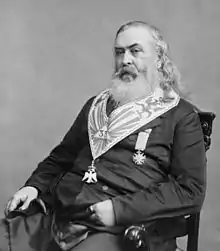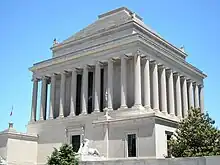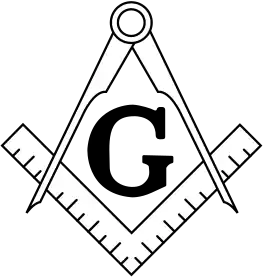| Part of a series on |
| Freemasonry |
|---|
 |
The Supreme Council, Ancient and Accepted Scottish Rite, Southern Jurisdiction, USA is the first Supreme Council of Scottish Rite Freemasonry, founded in 1801. Its official full name is "The Supreme Council (Mother Council of the World) of the Inspectors General Knights Commander of the House of the Temple of Solomon of the Thirty-third Degree of the Ancient and Accepted Scottish Rite of Freemasonry of the Southern Jurisdiction of the United States of America."[1] It is also commonly known as The Supreme Council, 33°, Southern Jurisdiction, or by some other varying degree of complete titulage. It is sometimes called the Mother Supreme Council of the World. It is the governing body of Scottish Rite Freemasonry in its jurisdiction,[2] and is one of five Supreme Councils in the United States, along with the Northern Masonic Jurisdiction, two Prince Hall Affiliated Supreme Councils, and the Supreme Council of Louisiana.
It claims that all other Supreme Councils and Subordinate Bodies of the Scottish Rite are derived from it,[3] although some degrees in the Scottish Rite were practiced before the Southern Jurisdiction was organized. It oversees the Scottish Rite in 35 states.[4] The other 15 states fall under the Northern Jurisdiction, which is an independent body.
The Scottish Rite is one of the appendant bodies of Freemasonry that a Master Mason may join for further exposure to the principles of Freemasonry. To join the Supreme Council, one must attain the 32° of the Scottish Rite. The 33° is an honorary degree which only some members obtain.
In the Southern Jurisdiction of the United States, the Supreme Council consists of no more than 33 members, and is presided over by a Grand Commander. Other members of the Supreme Council are called Sovereign Grand Inspectors General (SGIG), and each is the head of the Rite in his respective Orient (or state). Other heads of the various Orients who are not members of the Supreme Council are called Deputies of the Supreme Council.
An important philosophical document of the Southern Jurisdiction was Morals and Dogma of the Ancient and Accepted Scottish Rite of Freemasonry, written by Albert Pike in 1872. A copy of Morals and Dogma was given to every new member in the Southern Jurisdiction until 1974. The book given to new initiates then became Grand Commander Henry C. Clausen's Clausen's Commentaries On Morals and Dogma (1976), then Rex Hutchens' A Bridge to Light (1988). Following the adoption of the "Revised Standard Pike Ritual," Hutchens' book was revised in 2010 by Scottish Rite Grand Archivist and Grand Historian Arturo de Hoyos. Currently, de Hoyos' Scottish Rite Ritual Monitor and Guide (2007, rev. 2010) is now distributed to new members as is Albert Pike's Morals and Dogma: Annotated Edition (2011).
History
The Supreme Council was founded in Charleston, South Carolina in 1801.[4] In 1813, a member of the Supreme Council established in[5] New York a Supreme Council for the Northern Jurisdiction of the United States of America. In 1823, the Supreme Council granted jurisdiction of the fifteen states east of the Mississippi River and north of the Ohio River to the Supreme Council for the Northern Jurisdiction. [4]
In 1870, "its residence was moved to Washington, D.C.," although " its see remains in Charleston."[6]
In 1911 the Mother Supreme Council began construction of a national headquarters of the Supreme Council in the District of Columbia, called the House of the Temple. Finished in 1915, the House of the Temple remains their headquarters to this day. It is located at 1733 Sixteenth Street, NW.[4] The House of the Temple also contains the remains of Albert Pike, the author of Morals and Dogma.
Degree Structure
The degrees offered by the Southern Jurisdiction can be divided into four categories:[7]
- Lodge of Perfection - 4° through 14°
- Chapter of Rose Croix - 15° through 18°
- Council of Kadosh - 19° through 30°
- Consistory - 31° and 32°
As of 2023, the topics of the degrees are as follows:[8][9][10]
| Degree | Name | Setting and/or Topic | Degree | Name | Setting and/or Topic |
|---|---|---|---|---|---|
| 4° | Secret Master | Near the Holiest of Holies in Solomon's Temple | 19° | Grand Pontiff | Albert Pike created ritual following a general plot of the hero's journey |
| 5° | Perfect Master | Hiram Abiff's Funeral | 20° | Master of the Symbolic Lodge | Geometry and Virtues; Famous lawgivers including Hammurabi, Socrates and Confucius |
| 6° | Intimate Secretary | Non-biblical story of debts owed by Solomon to Hiram of Tyre | 21° | Noachite, or Prussian Knight | Imperial Free City of Dortmund in the 1190s |
| 7° | Provost and Judge | Phoenicians and Jews building the Temple | 22° | Knight of the Royal Ax, or Prince of Libanus | Prussian Knights |
| 8° | Intendant of the Building | Selection to succeed Hiram Abiff | 23° | Chief of the Tabernacle | Chapter 16 of the Book of Numbers |
| 9° | Elu of the Nine | Vengeance for Hiram Abiff's murder | 24° | Prince of the Tabernacle | Four Elements, Osiris, Mithra |
| 10° | Elu of the Fifteen | Execution of the murderers of Hiram Abiff | 25° | Knight of the Brazen Serpent | Sufism |
| 11° | Elu of the Twelve | Execution of the murderers of Hiram Abiff | 26° | Prince of Mercy, or Scottish Trinitarian | Comparative Religions |
| 12° | Master Architect | Adoniram, successor to Hiram Abiff | 27° | Knight of the Sun, or Prince Adept | Knighthood; Middle Ages |
| 13° | Royal Arch of Solomon | Vault of Enoch | 28° | Knight Commander of the Temple | El |
| 14° | Perfect Elu | Initiation Ceremony | 29° | Scottish Knight of Saint Andrew | Robert the Bruce |
| 15° | Knight of the East,
or Knight of the Sword, or Knight of the Eagle |
Ruins of Solomon's Temple and the throne room of Cyrus the Great during the Babylonian Captivity | 30° | Knight Kadosh, or
Knight of the White and Black Eagle |
Philip the Fair; Pope Clement V; Jacques De Molay; Seven Liberal Arts; Kabala |
| 16° | Prince of Jerusalem | Darius' support for rebuilding the Temple | 31° | Inspector Inquisitor | Egyptian Book of the Dead |
| 17° | Knight of the
East and West |
Execution of John the Baptist; Book of Revelation | 32° | Master of the Royal Secret | Esotericism; Pythagoreans; Zarathustrans; Magi; Kabbalists |
| 18° | Knight Rose Croix | Chamber of Darkness; Chamber of Hell; Chamber of the Mystic Rose | 33° | Inspector General | Tribe of Levi |
Philanthropy
The Supreme Council in 1928 made a gift of $1 million to the George Washington University in D.C., to fund the creation of a School of Business.[11]
Sovereign Grand Commanders

The head of the Southern Jurisdiction is titled the Sovereign Grand Commander. A total of 21 men have held this office since 1801. Albert Pike and John H. Cowel's tenures of 32 years were the longest.
The list of Sovereign Grand Commanders is as follows:
- 1801-1816: John Mitchell
- 1816-1822: Frederick Dalcho
- 1822-1826: Isaac Auld[12]
- 1826-1844: Moses Holbrook[13]
- 1844-1845: Jacob De La Motta (acting)[14]
- 1845-1846: Alexander McDonald
- 1846-1858: John H. Honour
- 1858-1859: Charles M. Furman (acting)
- 1859-1891: Albert Pike
- 1892-1893: James C. Batchelor
- 1893-1895: Philip C. Tucker
- 1895-1900: Thomas H. Caswell[15]
 House of the Temple - Headquarters of the Southern Jurisdiction in Washington D.C.
House of the Temple - Headquarters of the Southern Jurisdiction in Washington D.C. - 1901-1914: James D. Richardson
- 1914-1921: George F. Moore[16]
- 1921-1953: John H. Cowles
- 1952-1955: Thomas J. Harkms
- 1955-1969: Luther S. Smith
- 1969-1985: Henry C. Clausen
- 1985-2003: C. Fred Kleinknecht
- 2003-2019: Ronald A. Seale
- 2019-present: James D. Cole
References
- ↑ "FAQs about Masonry." Archived 2008-05-12 at the Wayback MachineThe Supreme Council, 33°, A.A. & S.R. of Freemasonry, S.J., USA, (2006). Accessed June 2, 2008.
- ↑ "About the Building" Archived 2007-10-29 at the Wayback Machine The Supreme Council, 33°, A.A. & S.R. of Freemasonry, S.J., USA (2006). Accessed June 2, 2008.
- ↑ "Scottish Rite History" Archived 2013-02-21 at the Wayback Machine Scottish Rite California. Accessed June 2, 2008.
- 1 2 3 4 "Southern Jurisdiction" Archived 2007-01-24 at the Wayback Machine The Supreme Council, 33°, A.A. & S.R. of Freemasonry, S.J., USA (2006). Accessed June 2, 2008.
- ↑ "A Brief History Of The AULD Bible". pubs.royle.com. Retrieved February 19, 2023.
- ↑ "History of the Rite". Scottish Rite of Freemasonry, S.J., U.S.A. Retrieved November 8, 2023.
- ↑ Rite, Savannah Scottish. "Savannah Scottish Rite". Savannah Scottish Rite. Retrieved October 8, 2023.
- ↑ Conway, Frank; Hodapp, Christopher L. (August 16, 2017). The Masonic Pageant: The Scottish Rite Degrees of the Supreme Council, NMJ. Cornerstone Book Publishers. ISBN 978-1-934935-92-7.
- ↑ Morals and Dogma of the Ancient and Accepted Scottish Rite of Freemasonry by Pike.
- ↑ Hutchens, Rex R.; Seale, Ronald A.; Hoyos, Arturo de. Bridge To Light: A Study In Masonic Ritual & Philosopy. The Supreme Council of the Scottish Rite.
- ↑ "School of Business" Archived 2008-08-27 at the Wayback Machine The GW Hatchet, January 11, 1928. Accessed June 2, 2008.
- ↑ "A Brief History Of The AULD Bible". pubs.royle.com. Retrieved February 19, 2023.
- ↑ "Letter from Moses Holbrook to John James Joseph Gourgas, 1830 October 30 · digitalVGW". digitalvgw.omeka.net. Retrieved February 19, 2023.
- ↑ Cohen, Theodore (April 29, 2018). "Jacob De La Motta, M.D.: An Early American Jewish Medical Pioneer". silo.tips. Retrieved July 25, 2023.
- ↑ "San Francisco Call 14 November 1900 — California Digital Newspaper Collection". cdnc.ucr.edu. Retrieved February 19, 2023.
- ↑ The American Tyler-keystone: Devoted to Freemasonry and Its Concerdant Others. J. H. Brownell. 1919.
External links
- "Scottish Rite Freemasonry" The Supreme Council, 33°, A.&A.S.R. of Freemasonry, S.J., USA (2008).
- "Scottish Rite History" Orient of California (2008).
- Scottish Rite Member Handbook (2016)

